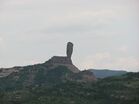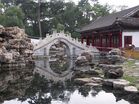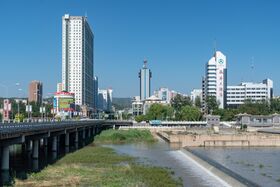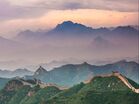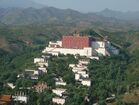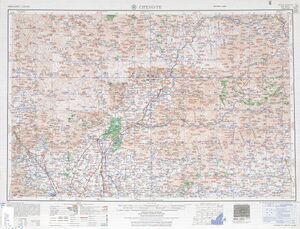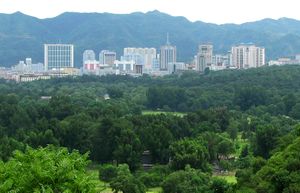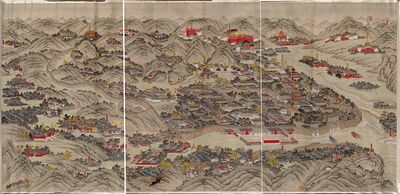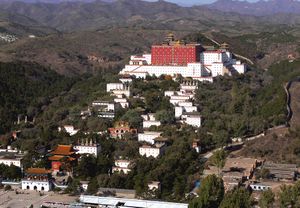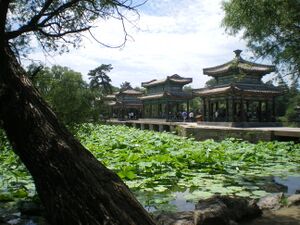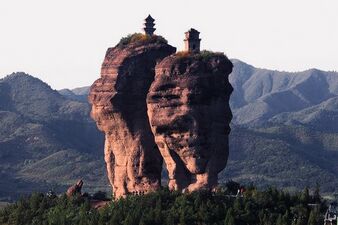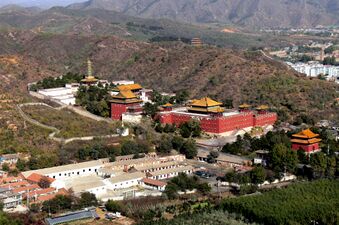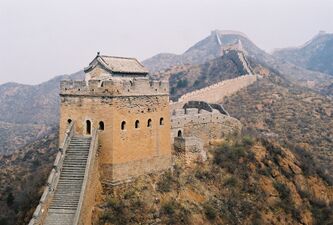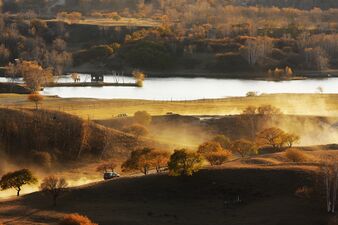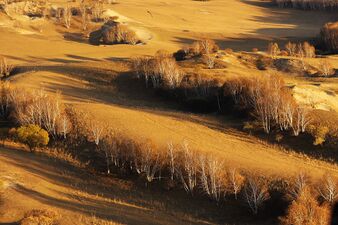تشنج دى
Chengde
承德市 Chengte, Jehol | |
|---|---|
Clockwise from top: Sledgehammer Peak, Mountain Resort, Skyline of Chengde, Putuo Zongcheng Temple, Jinshanling | |
 | |
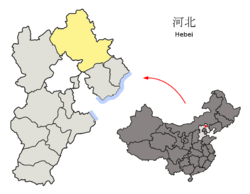 موقع تشـِنگدى في مقاطعة خهبـِيْ، وموقع مقاطعة خهبـِي في جمهورية الصين الشعبية | |
| الإحداثيات (Chengde municipal government): 40°57′11″N 117°57′47″E / 40.953°N 117.963°E | |
| Country | الصين |
| المقاطعة | خىبـِيْ |
| المساحة | |
| • مدينة بمستوى محافظة | 39٬519 كم² (15٬258 ميل²) |
| • الحضر | 709 كم² (274 ميل²) |
| المنسوب | 327 m (1٬073 ft) |
| التعداد (2020) | |
| • مدينة بمستوى محافظة | 3٬473٬200 |
| • الكثافة | 91/km2 (240/sq mi) |
| • Urban | 920٬395 |
| • الكثافة الحضرية | 1٬300/km2 (3٬400/sq mi) |
| • Districts[1] | 642٬000 |
| مفتاح الهاتف | 314 |
| ISO 3166 code | CN-HE-08 |
| License Plate Prefix | 冀H |
| GDP (2016) | CNY 14.329 billion |
| الموقع الإلكتروني | http://www.chengde.gov.cn |
City tree
Pagoda Tree City flower Rugosa Rose | |
| تشنج دى | |||||||||
|---|---|---|---|---|---|---|---|---|---|
| الاسم الصيني | |||||||||
| الصينية | 承德 | ||||||||
| البريد | Chengte | ||||||||
| المعنى الحرفي | Upholding Virtue Receiving Virtue | ||||||||
| |||||||||
| Rehe | |||||||||
| الصينية التقليدية | 熱河(兒) | ||||||||
| الصينية المبسطة | 热河(儿) | ||||||||
| البريد | Jehol | ||||||||
| المعنى الحرفي | Hot River | ||||||||
| |||||||||
| Mongolian name | |||||||||
| الكيريلية المنغولية | Халуун гол | ||||||||
| Mongolian script | ᠬᠠᠯᠠᠭᠤᠨ ᠭᠣᠣᠯ | ||||||||
| |||||||||
| Manchu name | |||||||||
| Manchu script | ᠊ᡵᡩᡝᠮᡠ ᠪᡝ ᠠᠯᡳᡥᠠ | ||||||||
| Abkai | Erdemu Be Aliha | ||||||||
تشـِنگدى مدينة سياحية جذابة في شمال الصين، تبعد عن العاصمة بكين حوالي مائتي كيلومتر، وهي منتجع صيفي مشهور في الصين، حيث تحيط بها جبال شاهقة وفي شمالها مروج واسعة، ولذلك دائما يتدفق الناس إليها للاستمتاع بالجو المنعش هناك خلال فصل الصيف الحار.
تتميز مدينة تشـِنج دى بحضارة عريقة. وقبل خمسة آلاف سنة، كانت مركزا لحضارة هونگشان ( الجبل الأحمر )، ومنطقة عاش فيها أبناء القوميات البدوية والزراعية معا. وفي عهد أسرة تشينغ الملكية، كان الأباطرة يعملون ويقضون الصيف هناك عندما يكون الجو حارا. ويعتبر المصيف الجبلي بچـِنده الذي تم بناءه في ذلك العهد أكبر حديقة امبراطورية موجودة حاليا في العالم. واليوم، يعيش أهل تشنغده بجانب المصيف الجبلي، ويرغبون في تبادل تجاربهم وخبراتهم مع الزوار من مختلف دول العالم..[2]
التاريخ
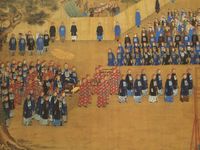
In 1703, Chengde was chosen by the Kangxi Emperor as the location for his summer residence. Constructed throughout the eighteenth century, the Mountain Resort was used by both the Yongzheng and Qianlong emperors. The site is currently an UNESCO World Heritage Site. Since the seat of government followed the emperor, Chengde was a political center of the Chinese empire during these times.
The city of Jehol — an early romanization of Rehe via the French transcription of the northern suffix ér as eul[3] — reached its height under the Qianlong Emperor 1735-1796 (died 1799). The great Putuo Zongcheng Temple, loosely based on the Potala in Lhasa, was completed after just four years of work in 1771. It was heavily decorated with gold and the emperor worshipped in the Golden Pavilion. In the temple itself was a bronze-gilt statue of Tsongkhapa, the Reformer of the Gelugpa sect.
Under the Republic of China, Chengde was the capital of Rehe province. From 1933 to 1945 the city was under Japanese control as a part of the Manchurian puppet state known as Manchukuo. After World War II the Kuomintang government regained jurisdiction. In 1948, the People's Liberation Army took control of Chengde. It would remain a part of Rehe until 1955, when the province was abolished, and the city was incorporated into Hebei.
The city is home to large populations of ethnic minorities, Mongol and Manchu in particular.
التقسيمات الإدارية
تشنجدى تضم:
| الخريطة | ||||||
|---|---|---|---|---|---|---|
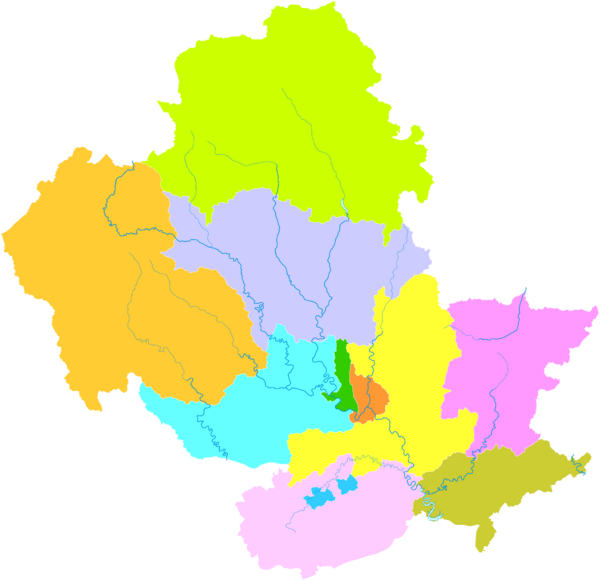
| ||||||
| Name | Hanzi | Hanyu Pinyin | Population (2004 est.) |
Area (km2) | Density (/km2) | |
| Shuangqiao District | 双桥区 | Shuāngqiáo Qū | 290,000 | 311 | 932 | |
| Shuangluan District | 双滦区 | Shuāngluán Qū | 100,000 | 250 | 400 | |
| Yingshouyingzi Mining District | 鹰手营子 矿区 |
Yīngshǒuyíngzi Kuàngqū |
70,000 | 148 | 473 | |
| Pingquan City | 平泉市 | Píngquán Shì | 470,000 | 3,297 | 143 | |
| Chengde County | 承德县 | Chéngdé Xiàn | 470,000 | 3,990 | 118 | |
| Xinglong County | 兴隆县 | Xīnglóng Xiàn | 320,000 | 3,116 | 103 | |
| Luanping County | 滦平县 | Luánpíng Xiàn | 320,000 | 3,195 | 100 | |
| Longhua County | 隆化县 | Lónghuà Xiàn | 420,000 | 5,474 | 77 | |
| Fengning Manchu Autonomous County |
丰宁满族 自治县 |
Fēngníng Mǎnzú Zìzhìxiàn |
380,000 | 8,747 | 43 | |
| Kuancheng Manchu Autonomous County |
宽城满族 自治县 |
Kuānchéng Mǎnzú Zìzhìxiàn |
230,000 | 1,933 | 119 | |
| Weichang Manchu and Mongol Autonomous County |
围场满族 蒙古族自治县 |
Wéichǎng Mǎnzú Měnggǔzú Zìzhìxiàn |
520,000 | 9,058 | 57 | |
الجغرافيا
Chengde is located in the northeastern portion of Hebei, with latitude 40° 12'-42° 37' N, and longitude 115° 54'-119° 15' E, and contains the northernmost point in the province. It borders Inner Mongolia, Liaoning, Beijing, and Tianjin. Neighbouring prefecture-level provincial cities are Qinhuangdao and Tangshan on the Bohai Gulf, and land-locked Zhangjiakou. Due to its Liaoning border, it is often considered a part of both the North and Northeast China regions. From north to south the prefecture stretches 269 kilometres (167 mi), and from west to east 280 kilometres (174 mi), for a total area of 39,702.4 square kilometres (15,329.2 sq mi), thus occupying 21.2% of the total provincial area. It is by area the largest prefecture in the province, though as most of its terrain is mountainous, its population density is low.
The Jehol or Rehe ("Hot River"), which gave Chengde its former name, was so named because it did not freeze in winter. Most sections of the river's former course are now dry because of modern dams.
المناخ
Chengde has a four-season, monsoon-influenced humid continental climate (Köppen Dwa), with widely varying conditions through the prefecture due to its size: winters are moderately long, cold and windy, but dry, and summers are hot and humid. Near the city, however, temperatures are much cooler than they are in Beijing, due to the higher elevation: the monthly 24-hour average temperature ranges from −9.3 °C (15.3 °F) in January to 24.2 °C (75.6 °F) in July, and the annual mean is 8.93 °C (48.1 °F). Spring warming is rapid, but dust storms can blow in from the Mongolian steppe; autumn cooling is similarly quick. Precipitation averages at about 504 millimetres (19.8 in) for the year, with more than two-thirds of it falling during the three summer months. With monthly percent possible sunshine ranging from 50% in July to 69% in October, the city receives 2,746 hours of sunshine annually.
| Climate data for تشنج دى (1981−2010 normals) | |||||||||||||
|---|---|---|---|---|---|---|---|---|---|---|---|---|---|
| Month | Jan | Feb | Mar | Apr | May | Jun | Jul | Aug | Sep | Oct | Nov | Dec | Year |
| Record high °C (°F) | 8.8 (47.8) |
18.9 (66.0) |
28.4 (83.1) |
31.6 (88.9) |
39.3 (102.7) |
38.8 (101.8) |
43.3 (109.9) |
38.9 (102.0) |
35.4 (95.7) |
30.1 (86.2) |
20.1 (68.2) |
12.2 (54.0) |
43.3 (109.9) |
| Mean daily maximum °C (°F) | −1.9 (28.6) |
3.0 (37.4) |
10.1 (50.2) |
19.3 (66.7) |
25.6 (78.1) |
29.2 (84.6) |
30.3 (86.5) |
29.2 (84.6) |
24.7 (76.5) |
17.4 (63.3) |
7.1 (44.8) |
−0.4 (31.3) |
16.1 (61.0) |
| Daily mean °C (°F) | −9.3 (15.3) |
−4.7 (23.5) |
2.7 (36.9) |
11.8 (53.2) |
18.2 (64.8) |
22.4 (72.3) |
24.2 (75.6) |
22.7 (72.9) |
17.1 (62.8) |
9.5 (49.1) |
−0.1 (31.8) |
−7.4 (18.7) |
8.9 (48.1) |
| Mean daily minimum °C (°F) | −14.8 (5.4) |
−10.7 (12.7) |
−3.8 (25.2) |
4.5 (40.1) |
11.0 (51.8) |
16.0 (60.8) |
19.2 (66.6) |
17.7 (63.9) |
11.0 (51.8) |
3.3 (37.9) |
−5.5 (22.1) |
−12.4 (9.7) |
3.0 (37.3) |
| Record low °C (°F) | −27.0 (−16.6) |
−23.7 (−10.7) |
−19.5 (−3.1) |
−8.3 (17.1) |
1.0 (33.8) |
7.4 (45.3) |
12.5 (54.5) |
7.9 (46.2) |
−0.1 (31.8) |
−10.6 (12.9) |
−18.8 (−1.8) |
−23.2 (−9.8) |
−27.0 (−16.6) |
| Average precipitation mm (inches) | 1.7 (0.07) |
3.8 (0.15) |
9.2 (0.36) |
21.3 (0.84) |
47.2 (1.86) |
88.0 (3.46) |
136.8 (5.39) |
108.1 (4.26) |
50.4 (1.98) |
26.8 (1.06) |
7.6 (0.30) |
2.6 (0.10) |
503.5 (19.83) |
| Average precipitation days (≥ 0.1 mm) | 1.6 | 2.1 | 3.7 | 4.5 | 7.8 | 11.1 | 14.2 | 12.6 | 7.7 | 5.0 | 2.5 | 1.4 | 74.2 |
| Average relative humidity (%) | 53 | 47 | 43 | 40 | 48 | 60 | 73 | 74 | 69 | 60 | 57 | 56 | 57 |
| Mean monthly sunshine hours | 195.6 | 202.3 | 240.6 | 258.7 | 276.4 | 262.0 | 229.1 | 234.0 | 240.2 | 236.2 | 193.5 | 177.2 | 2٬745٫8 |
| Percent possible sunshine | 66 | 68 | 65 | 65 | 62 | 58 | 50 | 55 | 64 | 69 | 65 | 62 | 62 |
| Source: China Meteorological Administration (precipitation days and sunshine 1971–2000)[4][5] | |||||||||||||
المعالم
The project of building Chengde Mountain Resort started in 1703 and finished in 1790. The whole mountain resort covers an area 5,640,000 square meters. It is the largest royal garden in China. The wall of the mountain resort is over 10,000 meters in length. In summers, emperors of the Qing dynasty came to the mountain resort to relax themselves and escape from the high temperature in Beijing.
The whole Resort can be divided into three areas which are lakes area, plains area and hills area. The lakes area, which includes 8 lakes, covers an area of 496,000 square meters. The plains area covers an area of 607,000 square meters. The emperors held horse races and hunted in the area. The largest area of the three is the hills area. It covers an area of 4,435,000 square meters. Hundreds of palaces and temples were built on the hills in this area.
The elaborate Mountain Resort features large parks with lakes, pagodas, and palaces ringed by a wall. Outside the wall are the Eight Outer Temples (外八庙), built in varying architectural styles drawn from throughout China. One of the best-known of these is the Putuo Zongcheng Temple, built to resemble the Potala Palace in Lhasa, Tibet. The resort and outlying temples were made a UNESCO World Heritage Site in 1994. The nearby Puning Temple, built in 1755, houses the world's tallest wooden statue of the Bodhisattva Avalokiteśvara.
Another popular attraction of the Chengde area is Sledgehammer Peak (磬锤峰), a large rock formation in the shape of an inverted sledgehammer. A variety of other mountains, valleys, and grasslands lie within the borders of the city.
معرض الصور
Jinshanling is a section of the Great Wall of China located in the mountainous area in Luanping County, Chengde.
Downtown Chengde, seen from the Mountain Resort.
Saihanba National Park, in northern Chengde, near the border with Inner Mongolia.
المدن الشقيقة
Chengde has city partnerships with the following locations:
 Santo André, São Paulo, Brazil
Santo André, São Paulo, Brazil Takasaki, Gunma, Japan
Takasaki, Gunma, Japan Dakota County, Minnesota, United States
Dakota County, Minnesota, United States Kashiwa, Chiba, Japan[6]
Kashiwa, Chiba, Japan[6]
الهوامش
- ^ أ ب خطأ استشهاد: وسم
<ref>غير صحيح؛ لا نص تم توفيره للمراجع المسماةCUCSY_2017 - ^ "تشنغده". تشنغده - إذاعة الصين الدولية. Retrieved 2011-06-30.
- ^ Forêt (2000), p. xiv.
- ^ 中国气象数据网 - WeatherBk Data (in Chinese (China)). China Meteorological Administration. Retrieved 2020-04-15.
- ^ 中国地面国际交换站气候标准值月值数据集(1971-2000年). China Meteorological Administration. Archived from the original on 2013-09-21. Retrieved 2010-05-25.
- ^ "International Exchange". List of Affiliation Partners within Prefectures (in الإنجليزية). Council of Local Authorities for International Relations (CLAIR). Archived from the original on 2016-03-04. Retrieved 21 November 2015.
المصادر
Hedin, Sven (1933). Jehol: City of Emperors. Reprint (2000): Pilgrim's Book House, Varanasi. ISBN 81-7769-009-4.
وصلات خارجية
- Pages using gadget WikiMiniAtlas
- Harv and Sfn no-target errors
- CS1 uses الصينية-language script (zh)
- CS1 Chinese (China)-language sources (zh-cn)
- Articles with hatnote templates targeting a nonexistent page
- Short description is different from Wikidata
- Coordinates on Wikidata
- Articles containing صينية-language text
- Articles containing منغولية-language text
- Articles containing simplified Chinese-language text
- مدن في مقاطعة خبى
- Prefecture-level divisions of Hebei
- تشـِنج دى
- أماكن مأهولة تأسست في القرن 18
- صفحات مع الخرائط
